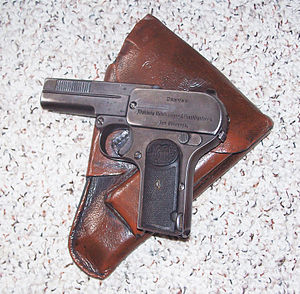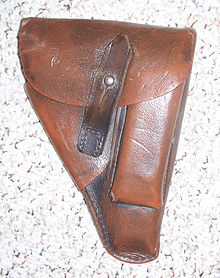- Dreyse M1907
-
Dreyse Model 1907 (Dryese M1907)
Dreyse m1907. This example has World War I Imperial German ordnance acceptance stamps, and a late WW2 issued Presstoff holsterType Semi-automatic pistol Place of origin  German Empire
German EmpireService history In service 1907–1945 Used by  Austria-Hungary
Austria-Hungary
 German Empire
German Empire
 Nazi Germany
Nazi Germany
 Ottoman Empire
Ottoman Empire
 Vatican City
Vatican CityWars World War I, World War II Production history Designer Louis Schmeisser Designed 1905–1906 Manufacturer Rheinische Metallwaren & Maschinenfabriken (Rheinische Metallwaren & Maschinenfabrik Sommerda) Produced 1907-1915[1] Specifications Weight 710 g (1 lb 9 oz) Length 160 mm (6.3 in) Barrel length 92 mm (3.6 in)[1] Cartridge 7.65 mm Browning (.32 ACP) Caliber 7.65 mm Action blowback, unlocked breech Muzzle velocity 365 m/s (1,200 ft/s)[dubious ][citation needed] Effective range Sights set for 25 m (82 ft) Maximum range 50 m (164 ft) effective range Feed system 7-round detachable single-stack magazine Sights Rear notch and front blade post The Dreyse Model 1907 is a semi-automatic pistol designed by Louis Schmeisser. The gun was named after Nikolaus von Dreyse, the designer of the Dreyse Needle Gun. The Waffenfabrik von Dreyse company was acquired by Rheinische Metallwaren & Maschinenfabrik Sommerda in 1901, although the Dreyse Model pistols were marketed under the Dreyse name.
The pistol had an interesting feature for the time: when the gun was ready to fire, the firing pin projected through the back of the breech block, serving as an early handgun-cocking indicator. For cleaning, the frame, receiver and slide pivoted forward on a pin in front of the trigger guard. The weapon its derivatives (Dreyse Model 1907 Pocket Pistol, Dreyse Model 1912 Parabellum) of simple blowback recoil operation, though of unusual design.[2]
The same company also manufactured a 6.35 mm pocket version (also named Model 1907). In 1912 the 9 mm Parabellum Dreyse Model 1912 emerged as the gun's successor. Marked as the RM & M Dreyse, it was chambered for 9 mm Parabellum.
Despite the gun's limited production time, the gun is relatively common today, in large part due to its use by Volkssturm and Volksgrenadier late in World War II, enabling many Allied servicemen to bring examples home as war trophies.[3]
Contents
Dreyse company
The Waffenfabrik von Dreyse was founded around 1841 to manufacture the famous Dreyse Needle gun for the Prussian Army, and they also made needle-pistols and caplock revolvers. The Dreyse Factory went into decline after the German Army adopted the Mauser in 1872. In 1901 Rheinische Metallwaren- & Maschinenfabrik of Sommerda purchased Waffenfabrik von Dreyse.
Development
Presstoff late-war holster issued to Volksgrenadiers
The Model 1907 Dreyse Pistol was designed by Louis Schmeisser (who had previously worked with Theodor Bergmann on the Bergmann Machine Gun) in 1905-6 and were marketed from 1907 onward. The first gun, the 7.65 mm Auto was the most unusual. Most of the cranked slide lay along the top of the barrel, with a short section projecting down behind the chamber to serve as the breech block. The breech block was confined within a flat-sided frame with a bridge to carry the back sight and arrest the upper section of the slide. The recoil spring surrounded the barrel, enclosed in the frame and held by a collar engaging the front end of the slide through a spring catch. Pulling back on the finger grips at the front of the slide brings the breech block into view behind the frame. The Dreyse pistol was fired by a striker whose tail protruded back through the rear of the breech block when the chamber was loaded. The entire top section of frame and slide could be pivoted on a pin in front of the trigger guard, being locked in the firing position by a catch at the rear of the frame. This final refinement was essential to dismantling; removal of the cranked slide would have been impossible otherwise.
The Dreyse design was strongly influenced by John Browning's FN M1900, though the Browning had its recoil spring above the barrel, while the Dreyse had a concentric recoil spring. Nonetheless, the overall shape was the same, as was the grip angle and surface design, the magazine release, the positioning of the manual safety and the breech blocks.
Design Modifications
The only major modification concerned the firing mechanism. Prior to 1915, the cocked striker had been held by the sear before being released by the trigger; pulling the trigger subsequently pushed the striker back before releasing it, compressing the striker spring to a greater extent. This was inspired by the later 9 mm Dreyse due to insensitive wartime ammunition. It allowed a second strike if the first misfired. Another wartime change involved a recess cut in the top front of the slide to facilitate removal of the recoil-spring retaining bush.
Variants
Early pistols were marked 'DREYSE Rheinische Metallwaren- & Maschinenfabrik ABT. SOMMERDA' on the left side of the frame and an 'RMF' monogram on the grips as shown above. Later pistols are usually marked 'DREYSE RHEINMETALL ABT. SOMMERDA'. A few pistols made in 1914 lack the 'DREYSE' marking. The pistol was also marketed commercially for police forces, including the Royal Saxon Gendarmerie, examples of which are marked as 'K. Sachs. Gend.'
Military Users
Primarily used by Austrian troops during World War I, especially officers of the Austro-Hungarian Habsburg Empire. Also used by officers of Imperial Germany during World War I. Examples issued to the Imperial German Army will have an acceptance proof above the ejection port on the right as well as the normal Crown N commercial proofs on the left side of the frame and slide near the trigger. Examples saw use by Wehrmacht troops (especially officers) during World War II. Nearing the end of the war many examples were issued to the Volksgrenadiere and Volkssturm, the latter often with so-called "last-ditch" Presstoff holsters. Large numbers of these were brought back to the United States by returning servicemen, which accounts for their availability in the country today. Typically the paper Presstoff holsters have not survived.
A few thousand were purchased by the Czech military in 1921 and 1922, but they were removed from service in 1923 due to unspecified accidents with them.
In 1912 the pope's Swiss Guard acquired thirty of these pistols for use by officers and non-commissioned officers. They remained in service with the Swiss Guard until 1990 when they were replaced by the SIG P225 pistol.[4]
During WW2 this pistol found its way to the Norwegian resistance. Quite a few of these pistols have, alongside home-made Sten-guns and illegal radios, been found hidden within the house-walls of norwegian resistance members and sympathisers. There has not been described any action in Norway with any Dreyse-pistols. As for the unspecified "accidents" with these pistols, the rear latch which holds the hinged upper part, may come loose. If this happens, the striker WILL move forward and ignite the cartridge. An unconfirmed civilian incident happened in the 80`s, where the shooter pierced his foot with the 7.65mm as a result of the latch coming loose.
Civilian Users
The Dreyse M1907 pistol was the first semi-automatic weapon used by a civilian police force - the Royal Saxon Gendarmerie and the Berlin police.
Importation
The Dreyse M1907 was never imported officially by contract into the United States, but significant numbers of them were brought back by GI's following World War II.
Notable Examples
The Deutsches Panzermuseum in Munster, Germany has an M1907 as the first display in its exhibit of German Army sidearms.
Trivia
The Dreyse M1907 appeared in the earlier versions of the board game Cluedo, mislabeled as a revolver.
References
- ^ a b J. B. Wood, The Gun Digest Book of Automatic Pistols, 2007, page 303. ISBN 0896894738.
- ^ c [1]
- ^ Wood, J.B. (1999). The Gun Digest Book of Firearms Assembly/Disassembly Part I - Automatic Pistols (Pt. 1). Krause Publications. p. 248. ISBN 0-8734-1783-6.
- ^ Oertle, V. "Vom Remington zum Sturmgewehr 90: Die Schusswaffen der Papstlichen Schweizergarde", page 22. Thesis, 2001
Manowar's Hungarian Weapons and History [2]
External links
Categories:- Semi-automatic pistols
- World War I German infantry weapons
- World War II German infantry weapons
- Early semi-automatic pistols
- .32 ACP firearms
Wikimedia Foundation. 2010.


